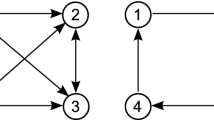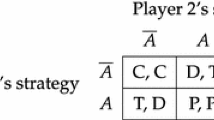Abstract
The paper describes a solution concept forn-person noncooperative games, developed jointly by the author and Reinhard Selten. Its purpose is to select one specific perfect equilibrium points=s (G) as the solution of any given noncooperative gameG. The solution is constructed by an inductive procedure. In defining the solutions (G) of gameG, we use the solutionss (G *) of the component gamesG * (if any) ofG; and in defining the solutions (G*) of any such component gameG *, we use the solutionss (G **) of its own component gamesG ** (if any), etc. This inductive procedure is well-defined because it always comes to an end after a finite number of steps.
At each level, the solution of a game (or of a component game) is defined in two steps. First, aprior subjectiveprobability distribution p i is assigned to the pure strategies of each playeri, meant to represent the other players' initial expectations about playeri's likely strategy choice. Then, a mathematical procedure, called thetracing procedure, is used to define the solution on the basis of these prior probability distributionsp i . The tracing procedure is meant to provide a mathematical representation for thesolution process by which rational players manage to coordinate their strategy plans and their expectations, and make them converge to one specific equilibrium point as solution for the game
Similar content being viewed by others
References
Harsanyi, J. C.: A General Solution for Finite Non-cooperative Games, Based on Risk-Dominance, inM. Dresher, L.S. Shapley, andA.W. Tucker (ed.): Advances in Game Theory. Princeton, N.J., 1964.
—: Games with Incomplete Information Played by ‘Bayesian’ Players, Parts I – III, Management Science14, 1967–68, 159–182, 320–334, and 486–502.
—: The Tracing Procedure: A Bayesian Approach to Defining a Solution forn-Person Noncooperative Games, International Journal of Game Theory4, 1975, 61–94.
Nash, J.F.: The Bargaining Problem, Econometrica18, 1950, 155–162.
—: Noncooperative Games, Annals of Mathematics54, 1951, 286–295.
Selten, R.: Reexamination of the Perfectness Concept for Equilibrium Points in Extensive Games. International Journal of Game Theory4, 1975, 25–55.
Author information
Authors and Affiliations
Rights and permissions
About this article
Cite this article
Harsanyi, J.C. A solution concept forn-person noncooperative games. Int J Game Theory 5, 211–225 (1976). https://doi.org/10.1007/BF01761604
Received:
Issue Date:
DOI: https://doi.org/10.1007/BF01761604




